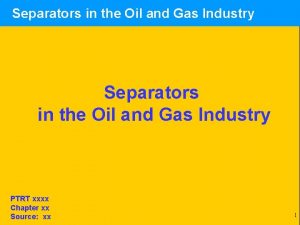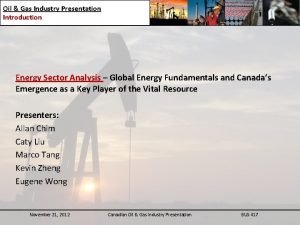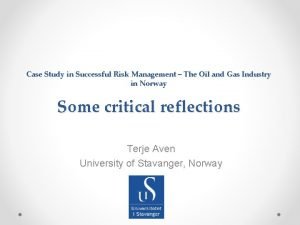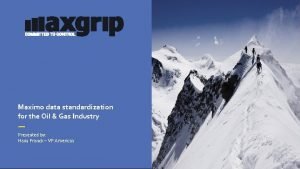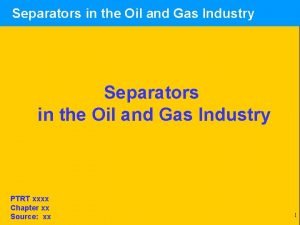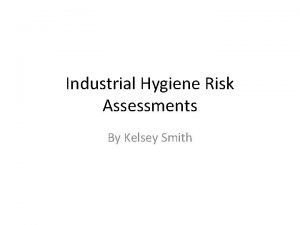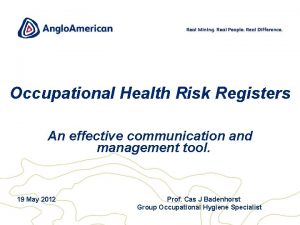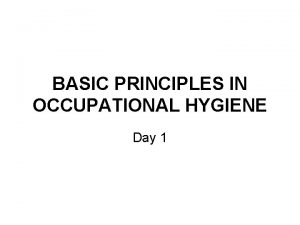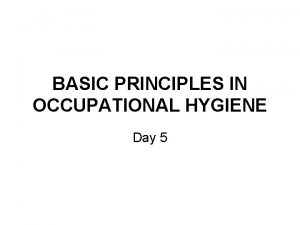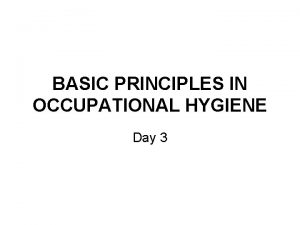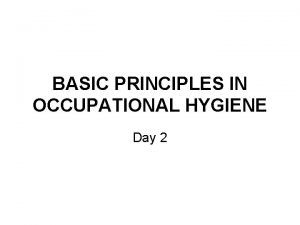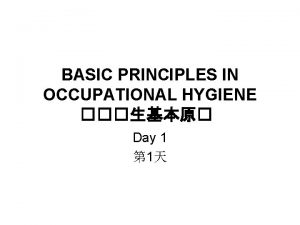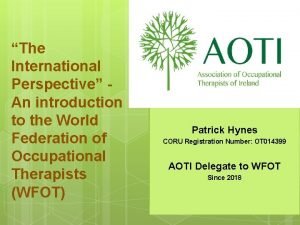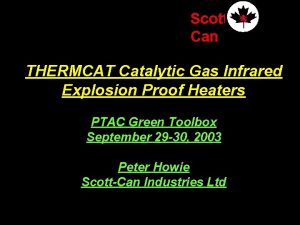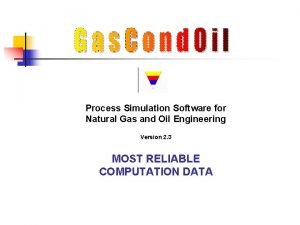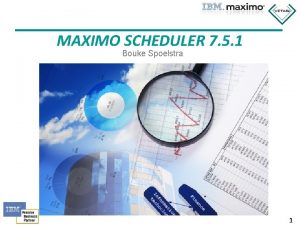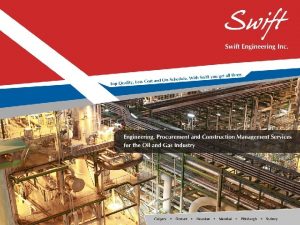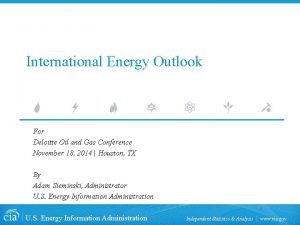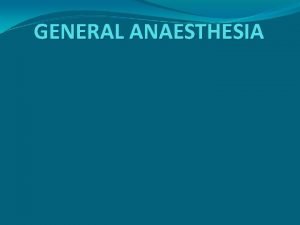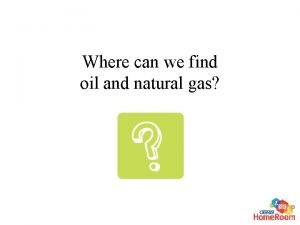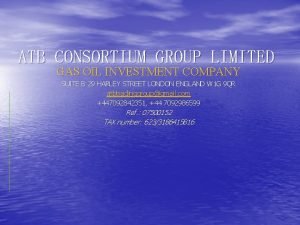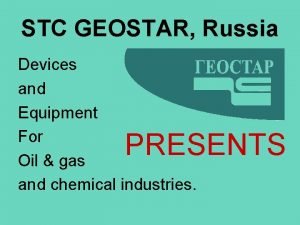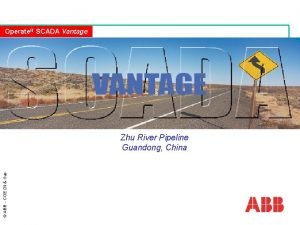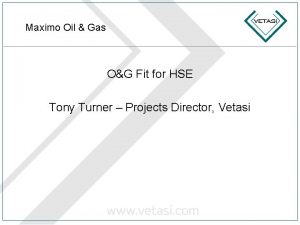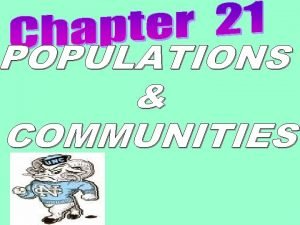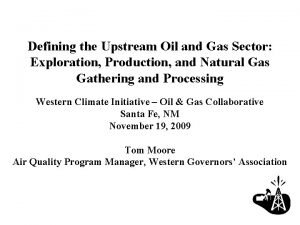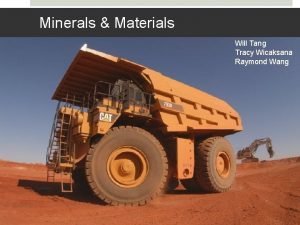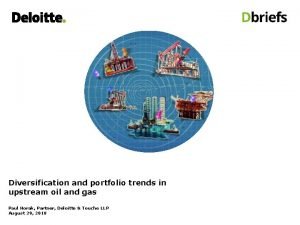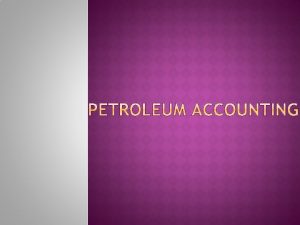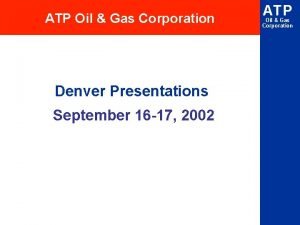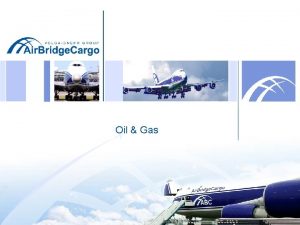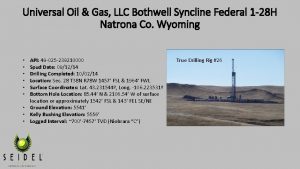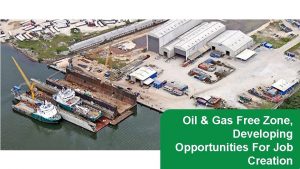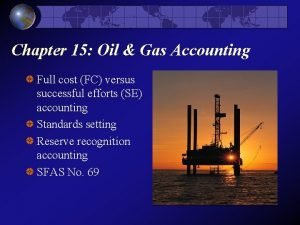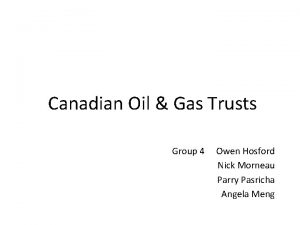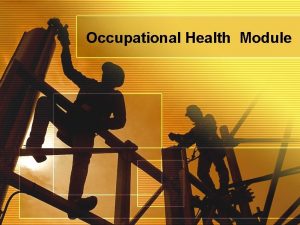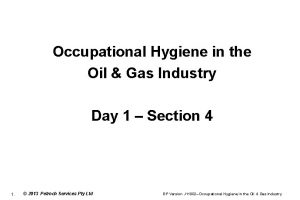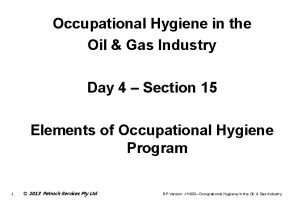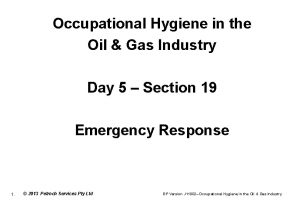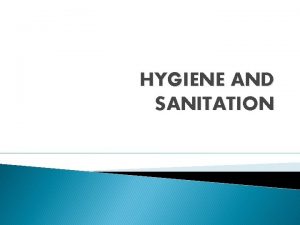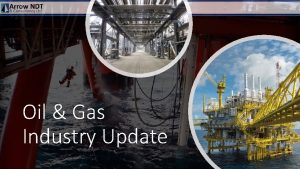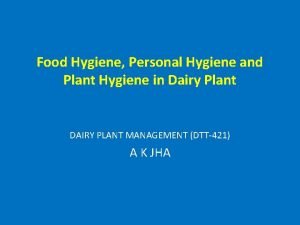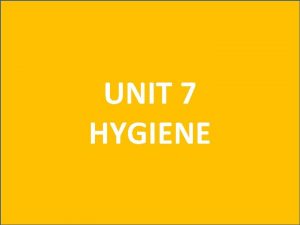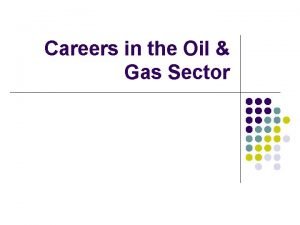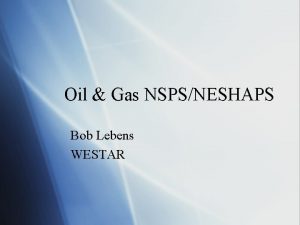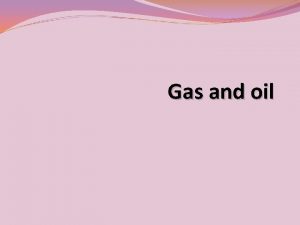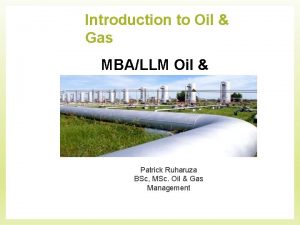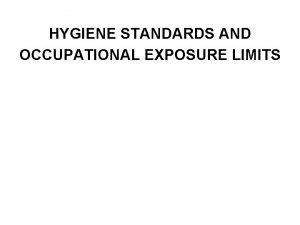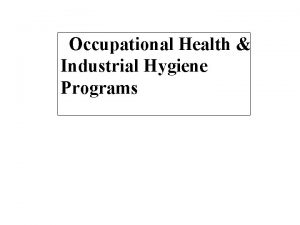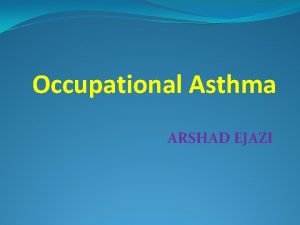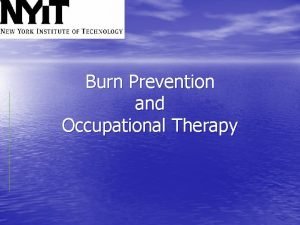Occupational Hygiene in the Oil Gas Industry Day
















































- Slides: 48

Occupational Hygiene in the Oil & Gas Industry Day 2 – Section 8 Production Processes Oil Refineries 1. © 2013 Petroch Services Pty Ltd BP Version J 11002– Occupational Hygiene in the Oil & Gas Industry

Overview of Refining Processes – Fuel & Lubes Separation of crude oil into various fractions. • Gas – LPG (Propane, Butane) • Gasolines, Naphthas – Petrol, Avgas, Solvents • Kerosenes – Home kerosene, Jet Fuel, Light Heating Oils, Solvents • • • 2. Diesels – Automotive diesel fuel (ADO) Fuels oils – Bunker fuel Bitumens – Road making, other products Lube Oil Feedstock – production of Lube oils Petrochemical Feedstock – plastics production © 2013 Petroch Services Pty Ltd BP Version J 11002– Occupational Hygiene in the Oil & Gas Industry

Refineries • • Refinery - land based, fixed installation Close to coast or river systems for shipping Connect to markets by pipelines Loading facilities to receive crude oil and feed stocks • Load-out facilities to distribute products • Crude supplied by ship, pipeline or rail car. • Capacity 100, 000 -300, 000 Bbls/day Smallest <50, 000 Bbls/day (<8 million Litres/day to Largest 1, 000 Bbls/day (180 million Litres/day) 3. © 2013 Petroch Services Pty Ltd BP Version J 11002– Occupational Hygiene in the Oil & Gas Industry

Typical Layout of Fuels Refinery 4. © 2013 Petroch Services Pty Ltd BP Version J 11002– Occupational Hygiene in the Oil & Gas Industry

Typical Layout of Fuels Refinery Process Units 5. © 2013 Petroch Services Pty Ltd BP Version J 11002– Occupational Hygiene in the Oil & Gas Industry

PROCESS FLOW – FUELS REFINERY DISTILLATION • Atmospheric Crude (oil) Distillation unit – primary distillation of crude oil into fractions based on boiling range • - gas, naphtha, kerosenes, middle distillates (gas oils) and residual oils (‘bottoms’) • Vacuum Distillation – the secondary distillation of residual oils from atmospheric distillation to make feedstock for the Catalytic Cracker and feed stocks for bitumen plants or lube oil refining 6. © 2013 Petroch Services Pty Ltd BP Version J 11002– Occupational Hygiene in the Oil & Gas Industry

Distillation Fractions Carbon Number Boiling Range Name Deg. C Deg. F C 1 -C 4 <0 <30 C 4 -C 12 0 -200 30 -392 Naphtha C 12 -C 15 200 -300 392 -572 Kerosene, Jet Fuel C 15 -C 25 300 -400 572 -750 Gas Oil, Heating Oil, Diesel >400 >750 >C 25 Gas Bottoms, Residuum, Vacuum Distillation Feedstock 7. © 2013 Petroch Services Pty Ltd BP Version J 11002– Occupational Hygiene in the Oil & Gas Industry

PROCESS FLOW – FUELS REFINERY CONVERSION PROCESSES • Catalytic Cracking unit (FCC), (TCC) - residual oils (bottoms) ‘crack’ heavy molecules into lighter fractions gas, naphtha, middle distillates (gas oils) and heavy oils. • Catalytic Reformers - low octane naphtha, change molecules in a hydrogen rich atmosphere to make high octane gasoline blend stocks • Alkylation Unit - light hydrocarbon gases (propylene, butylene with iso butane) combined to produce high octane (liquid) gasoline blend stocks, using Sulphuric or hydrofluoric, or phosphoric acid 8. © 2013 Petroch Services Pty Ltd BP Version J 11002– Occupational Hygiene in the Oil & Gas Industry

FCC Unit showing the Large Reactor and Fractionating Towers 9. © 2013 Petroch Services Pty Ltd BP Version J 11002– Occupational Hygiene in the Oil & Gas Industry

Thermofor Catalytic Cracker 10. © 2013 Petroch Services Pty Ltd BP Version J 11002– Occupational Hygiene in the Oil & Gas Industry

Small Fuels Refinery 11. © 2013 Petroch Services Pty Ltd BP Version J 11002– Occupational Hygiene in the Oil & Gas Industry

12. © 2013 Petroch Services Pty Ltd BP Version J 11002– Occupational Hygiene in the Oil & Gas Industry

13. © 2013 Petroch Services Pty Ltd BP Version J 11002– Occupational Hygiene in the Oil & Gas Industry

PROCESS FLOW – LUBE REFINERY • Vacuum Distillation - to process atmospheric tower residues and remove the light components (gas oils). • Extraction Process (Furfural) - to remove poly aromatic hydrocarbons (PAH or PNA) • Methyl Ethyl Ketone dewaxing - to remove wax • Hydrofinishing Unit - to remove unsaturated hydrocarbons leaving a finished lubricating base oil of various grades. 14. © 2013 Petroch Services Pty Ltd BP Version J 11002– Occupational Hygiene in the Oil & Gas Industry

Lube Oil Refinery Process Flow 15. © 2013 Petroch Services Pty Ltd BP Version J 11002– Occupational Hygiene in the Oil & Gas Industry

16. © 2013 Petroch Services Pty Ltd BP Version J 11002– Occupational Hygiene in the Oil & Gas Industry

Fuel and Lube Processes Refinery processes – broad categories • Fractionation Processes (Distillation) • Conversion Processes—decomposition • Conversion Processes—unification • Conversion Processes—alteration or rearrangement • Treatment Processes • Utilities 17. © 2013 Petroch Services Pty Ltd BP Version J 11002– Occupational Hygiene in the Oil & Gas Industry

Understand the Process, Products and Hazards Fractionation - Distillation Process Name Action & Purpose Atmos. distillation Vacuum distillation 18. Product(s) Potential Health Hazards Separation – Desalted Thermal, crude oil Separate fractions Gas, naphtha, gas oil, distillate, residual Hydrocarbons. (Paraffinic, Olefinic, Naphthenic, Aromatic, PAH, Carbon (Coke) H 2 S, Mercaptans. Heat, Noise, Insulation materials Separation – Thermal, Separate without cracking Gas oil, lube Hydrocarbons, (Paraffinic, stock, Olefinic, Naphthenic, residual Aromatic, PAH, Carbon (Coke). Heat, Noise, Insulation materials © 2013 Petroch Services Pty Ltd Feedstock Atmos. tower residual BP Version J 11002– Occupational Hygiene in the Oil & Gas Industry

CONVERSION PROCESSES—DECOMPOSITION Catalyt ic crackin g Gas oil, coke distillate Gasoline blend stock, petrochemical feedstock Hydrocarbons, Carbon (Coke) including Benzene Aromatic oils, PAH, Carbon Monoxide, H 2 S, Mercaptans. Sulphur oxides. Gases, Catalyst dust, Heat, Noise, Insulation materials Coking Polymerize/ Gas oil, desulphur. coke Thermal, distillate Convert vacuum residuals Gasoline blend stock, , petrochemical feedstock, coke Hydrocarbons including Benzene (~2%%), Aromatic oils, PAH Carbon Monoxide, H 2 S, coke dust, Heat, Noise, Insulation materials Hydro- Hydrog. crackin Catalytic, g Convert to lighter Hydrocarbons Gasoline blend stock, , Lighter, higher-quality products 19. Alter (crack) molecules Catalytic, Upgrade gasoline © 2013 Petroch Services Pty Ltd Gas oil, cracked oil, residual Hydrocarbons, Gasoline Hydrogen, Carbon Monoxide, CO 2, H 2 S, Mercaptans. Sulphur oxides, Metal Carbonyls, BP Version J 11002– Metal Occupational Hygiene in the Oil. Catalyst & Gas Industry sulphides,

CONVERSION PROCESSES—UNIFICATION Alkylati on 20. Combining gases Catalytic (Sulphuric, or Hydrofluoric, or Phosphoric) Acid Combine olefins & isoparaffi ns © 2013 Petroch Services Pty Ltd Atm. tower & Cracker isobutane / cracker olefin Iso-octane (alkylate) Gasoline blend stock, Hydrocarbons (Paraffins, Olefins), Gases, Caustics, Amines, Acids (Sulphuric or Hydrofluoric, or Phosphoric) Acid sludge, Noise BP Version J 11002– Occupational Hygiene in the Oil & Gas Industry

Alkylation Unit Process Flow 21. © 2013 Petroch Services Pty Ltd BP Version J 11002– Occupational Hygiene in the Oil & Gas Industry

Alkylation Process – Sulphuric Acid Isobutane + Olefins Propylenes Butylenes 22. © 2013 Petroch Services Pty Ltd BP Version J 11002– Occupational Hygiene in the Oil & Gas Industry

Alkylation Process – Aviation gasoline, high octane blend stock • Light Alkylate C 7 to C 8 highly branched paraffins • RON ~ 94 (unleaded) Includes 2, 2, 4 Trimethyl Pentane (‘Iso Octane’) Octane rating standard = 100 Normal Heptane, octane rating standard = 0 23. © 2013 Petroch Services Pty Ltd BP Version J 11002– Occupational Hygiene in the Oil & Gas Industry

CONVERSION PROCESSES—ALTERATION OR REARRANGEMENT Catalytic reforming Alteratio Upgrade Coker/ n/ dehydr. low-octane hydro. Catalytic naphtha cracker naphtha High octane Reformate/ aromatic Hydrocarbons, H 2 S, Benzene, Catalyst dust. Metal Carbonyls, Metal sulphides, Heat, Noise, Insulation materials, Hydrogen Isomerizati Rearran Convert on ge straight Catalytic chain to branch Butane, Isobutane/ Hydrocarbons, pentane, isopentane Hydrogen, Hydrogen hexane / isohexane Chloride, Aluminium Chloride, Antimony Chloride, Catalyst dust, Heat, Noise Benzene Reduction Reformat e (Benzen e 5 -10%) 24. © 2013 Hydrog. Convert Catalytic Benzene into branched hydrocarb Petroch Services Pty Ltd Gasoline blend stock Benzene (<1%) Hydrocarbons, Hydrogen, Metal Carbonyls, Metal sulphides, Catalyst dust, Hygiene Heat, BP Version J 11002– Occupational in the. Noise, Oil & Gas Industry

TREATMENT PROCESSES Amine treating Treatment Absorption Remove acidic contaminants Desalting Dehydration/ Electrostatic Absorption Sour gas, H/C, CO 2 H 2 S, RSH Acid free Hydrocarbons CO 2 gases & , H 2 S, Mercaptans, liquid Amines, Caustic hydrocarbo ns Crude oil Desalted crude oil Hydrocarbons, H 2 S, Mercaptans Drying & Treatment Absorption/ Liquid sweeten thermal H/Cs, LPG, alky feedstock Sweet & Hydrocarbons, CO 2 dry , H 2 S, Mercaptans, hydrocarbo Amines, Caustic ns Furfural extractio n Cycle oils & lube feedstocks High quality diesel & lube oil Hydrocarbons, PAH, Furfural Highsulphur residual/ Desulph. product Hydrocarbons, H 2 S, Mercaptans Solvent extraction. Absorption Upgrade lubes Hydro – Treatment Catalytic desulphu Remove sulphur, © 2013 Petroch Services Pty Ltd r. 25. contaminants BP Version J 11002– Occupational Hygiene in the Oil & Gas Industry

Utilities - 1 • Steam Generation –heat, noise, H 2 S, sulphur dioxide, water treatment chemicals, CO 2, hydrocarbons, insulation materials (asbestos, SMF) • Power Generation – Gas turbine power generation to provide electrical services. High noise source from gas turbines. • Cooling Towers – Hazards from contamination of cooling water by process streams and water treatment chemicals. – Additives, Corrosion inhibitors Chemicals - chlorine, algaecides, chromates, zinc, dichromates, organic phosphate. – Potential source of Legionella – Noise from fans and pumps. 26. © 2013 Petroch Services Pty Ltd BP Version J 11002– Occupational Hygiene in the Oil & Gas Industry

Utilities - 2 • Waste Water Treatment – Hazards are gases, liquids or particulates. – Also include acids, alkali, metal salts, zeolites, silicious dust, chlorine dioxide, CO 2, alcohols, hydrogen sulphide, benzene, disulphides. Heat and noise from incinerators. • Flares - Heat and noise, gases, (liquids), steam 27. © 2013 Petroch Services Pty Ltd BP Version J 11002– Occupational Hygiene in the Oil & Gas Industry

Maintenance & Workshops Maintenance activities can be grouped into three categories: • Preventative (scheduled) maintenance – planned inspections • Emergency (non-scheduled) maintenance, repairs of failed equipment • “Turnarounds” – shutdown and major overhaul and inspections (taking 5 to 40 days). 28. © 2013 Petroch Services Pty Ltd BP Version J 11002– Occupational Hygiene in the Oil & Gas Industry

Petroleum Refining (Fuel & Lube) Processes and Their Potential Health Hazards • Hydrocarbons. (Paraffinic, Olefinic, Naphthenic, Aromatic, Benzene, PAH, Carbon (Coke), Aromatic oils, PAH (boiling point >385 deg C) • Hydrogen, Carbon Monoxide, Carbon Dioxide, H 2 S, Mercaptans, Sulphur oxides, Gases • Catalyst dust, Metal Carbonyls, Metal sulphides • Caustics, Amines, Acids (Sulphuric or Hydrofluoric, or Phosphoric) Acid sludge • Heat, Noise, Insulation materials. 29. © 2013 Petroch Services Pty Ltd BP Version J 11002– Occupational Hygiene in the Oil & Gas Industry

OH Issues For Refineries a) b) c) d) e) f) g) h) i) 30. Hazardous Substances Thermal Environment Noise Asbestos and Other Fibres Ergonomic Radiation Maintenance & Turnaround Hazards Other Hazards Environmental hazards © 2013 Petroch Services Pty Ltd BP Version J 11002– Occupational Hygiene in the Oil & Gas Industry

OH Issues (a) Hazardous Substances • Process streams and contaminants – crude oil, (condensate), Mercury, Hydrogen sulphide and sulphur compounds • Purchased chemicals and products – catalysts, treatment chemicals (amines, caustic) - this requires a chemical inventory and MSDS information • Generated substances e. g. welding fume, catalyst dust • Generated waste and waste disposal • Odour control - environmental 31. © 2013 Petroch Services Pty Ltd BP Version J 11002– Occupational Hygiene in the Oil & Gas Industry

OH Issues (b) Thermal Environment • General environment & location • Refineries usually located on land in populated areas relatively close access to shipping and/or pipelines. This can be in cold or hot climates. 32. © 2013 Petroch Services Pty Ltd BP Version J 11002– Occupational Hygiene in the Oil & Gas Industry

OH Issues (c) Noise • Noise from process units, utilities and maintenance activities • High noise sources are heaters, compressors and generators (typically >105 d. BA) however with modern designs and improved engineering the refineries may be able to achieve noise levels < 85 d. BA • Community noise becomes an issue 33. © 2013 Petroch Services Pty Ltd BP Version J 11002– Occupational Hygiene in the Oil & Gas Industry

OH Issues (d) Asbestos and Other Fibres Removal of asbestos insulation 34. © 2013 Petroch Services Pty Ltd BP Version J 11002– Occupational Hygiene in the Oil & Gas Industry

OH Issues (e) Ergonomic • Ergonomic hazards associated with any facility • Opening/closing valves – poor posture 35. © 2013 Petroch Services Pty Ltd BP Version J 11002– Occupational Hygiene in the Oil & Gas Industry

OH Issues (f) Radiation • Ionizing – Radiation – level measurement, radiography • Non-Ionizing Radiation- Visible – Lighting • UV radiation (sun, welding) • NORM (Naturally Occurring Radioactive Material) usually not a significant problem in refineries as nearly all the NORM has been retained in upstream gas plants near the crude oil source 36. © 2013 Petroch Services Pty Ltd BP Version J 11002– Occupational Hygiene in the Oil & Gas Industry

Radiation – FCC Level Gauge 37. © 2013 Petroch Services Pty Ltd BP Version J 11002– Occupational Hygiene in the Oil & Gas Industry

OH Issues (g) Maintenance & Turnarounds • Planned and unplanned shutdowns • Potential release of product • Inspection of process equipment both external and internal – confined space entry • Turnarounds – Increased workforce – trained & untrained – Untrained and unskilled workforce need training on O&G hazards 38. © 2013 Petroch Services Pty Ltd BP Version J 11002– Occupational Hygiene in the Oil & Gas Industry

OH Issues (h) Other Hazards • Location hazards – on land, insects, disease (Cholera, Malaria, HIV) • Legionella (from cooling towers) • Civil Unrest - stability of government • Security of site. • Generally refineries are located in populated areas, therefore the hazards associated with remote and isolated operations do not apply. However other subjects come into consideration – public safety, site security, community impact - environmental 39. © 2013 Petroch Services Pty Ltd BP Version J 11002– Occupational Hygiene in the Oil & Gas Industry

OH Issues (i) Environmental Hazards • Environmental hazards – earthquakes, hurricanes, flood, and fire 40. © 2013 Petroch Services Pty Ltd BP Version J 11002– Occupational Hygiene in the Oil & Gas Industry

Other hazards – LPG 41. © 2013 Petroch Services Pty Ltd BP Version J 11002– Occupational Hygiene in the Oil & Gas Industry

Health Hazards of Some Petroleum Operations Boiler house - Noise, Asbestos insulation, SMF insulation, Water treatment chemicals Cooling towers - Water treatment chemicals, Legionella Waste water treatment - Water treatment chemicals, hydrocarbons Drum fill operations - Hydrocarbons, Noise, ergonomics (manual handling) – Various types of filling Tank truck fill operations & driving - Hydrocarbons, Noise, ergonomics (manual handling), driver fatigue – Various types of loading Rail car fill operations - Hydrocarbons, Noise, ergonomics (manual handling) – Various types of loading Ship loading operations - Hydrocarbons, Noise, ergonomics (manual handling) - Various types of loading 42. © 2013 Petroch Services Pty Ltd BP Version J 11002– Occupational Hygiene in the Oil & Gas Industry

Health Hazards of Some Petroleum Operations Tank Cleaning - Hydrocarbons, Noise, lead (alky lead), PAH (oils), confined spaces, ergonomics (manual handling), hydro blasting and water washing tanks. Use of compressed air (breathing air) Tank repairs - Hydrocarbons, Noise, lead (alky lead), lead based paints, epoxy paints, confined spaces, welding fumes, dust Repair of tank floors, grinding, welding, grit blasting, repainting internals Maintenance/Workshop - Cleaning chemicals, carbon monoxide 43. © 2013 Petroch Services Pty Ltd BP Version J 11002– Occupational Hygiene in the Oil & Gas Industry

Tank Repair – Confined Space 44. © 2013 Petroch Services Pty Ltd BP Version J 11002– Occupational Hygiene in the Oil & Gas Industry

Health Hazards of Some Petroleum Operations Warehouse operations - CO, forklifts, ergonomics (manual handling) movement of drums, loading trucks Waste product recovery, drum cleaning - Hydrocarbons, Noise, ergonomics (manual handling) Fuel Testing Laboratory - Hydrocarbons, Noise, ergonomics (manual handling), alkyl lead, chemicals, Engine laboratory (knock engine operators), lab technicians/chemists 45. © 2013 Petroch Services Pty Ltd BP Version J 11002– Occupational Hygiene in the Oil & Gas Industry

Health Hazards of Some Petroleum Products Product Hazard Health Hazard Gasoline Benzene Skin, eye contact, vapour inhalation Long term exposure to Benzene may result in blood disorders – leukaemia Skin, eye irritation, respiratory irritation, dizziness, loss of consciousness Kero. Heating oil Skin, eye contact Excessive inhalation unlikely, however if product is aspirated (sprayed) then potential respiratory hazards Skin, eye irritation. Repeated exposure may cause skin dryness or cracking. May cause lung damage if swallowed. Gas oils, Diesels, Residual Fuels Skin, eye contact. Excessive inhalation unlikely however if product is aspirated (sprayed) then potential respiratory hazards, Polyaromatic Hydrocarbons (PAH, PCA) Skin, eye irritation, Repeated exposure may cause skin dryness or cracking. May cause lung damage if swallowed. In extreme cases of poor personal hygiene and prolonged and repeated contact there may be a possibility of skin cancer 46. © 2013 Petroch Services Pty Ltd BP Version J 11002– Occupational Hygiene in the Oil & Gas Industry

Summary Understand the Process, Products, Hazards and observe what People do • Processes – What are the operations? • Products – What are the components? • Potential Hazards – What are the hazards? (chemical, noise, thermal, radiation, asbestos & fibres, ergonomics, biological, other considerations, environment) • People - What they do? Routine and non routine (maintenance, turnarounds) 47. © 2013 Petroch Services Pty Ltd BP Version J 11002– Occupational Hygiene in the Oil & Gas Industry

End of Section 8 Refineries 48. © 2013 Petroch Services Pty Ltd BP Version J 11002– Occupational Hygiene in the Oil & Gas Industry
 Day 1 day 2 day 3 day 4
Day 1 day 2 day 3 day 4 Types of separators in oil and gas industry
Types of separators in oil and gas industry Introduction to oil and gas industry ppt
Introduction to oil and gas industry ppt Risk management case study oil and gas industry
Risk management case study oil and gas industry Maximo for oil and gas
Maximo for oil and gas Types of separators in oil and gas industry
Types of separators in oil and gas industry Hygiene risk assessment
Hygiene risk assessment Occupational hygiene programme template
Occupational hygiene programme template Basic principles of occupational hygiene
Basic principles of occupational hygiene Principles of occupational hygiene
Principles of occupational hygiene Basic principles of occupational hygiene
Basic principles of occupational hygiene Basic principles of occupational hygiene
Basic principles of occupational hygiene Basic principles of occupational hygiene
Basic principles of occupational hygiene Day 1 day 2 day 817
Day 1 day 2 day 817 Primary emulsion formula for fixed oil
Primary emulsion formula for fixed oil Occupational therapy day
Occupational therapy day Scott can industries
Scott can industries Process simulation software in oil and gas market
Process simulation software in oil and gas market Maximo assignment manager application
Maximo assignment manager application Gomaximo
Gomaximo Madagascar oil and gas
Madagascar oil and gas Full suite company
Full suite company Deloitte oil and gas
Deloitte oil and gas Second gas effect
Second gas effect Hitachi vantara oil and gas
Hitachi vantara oil and gas Drops oil and gas
Drops oil and gas Uses of oil and gas
Uses of oil and gas Atb oil and gas
Atb oil and gas Echometer oil and gas
Echometer oil and gas Scadavantage
Scadavantage Osu oil and gas accounting conference
Osu oil and gas accounting conference Roles of a planner
Roles of a planner Maximo oil
Maximo oil Energy roles
Energy roles Oil and gas
Oil and gas Oil and gas revenue accounting basics
Oil and gas revenue accounting basics Darren prins
Darren prins Oil and gas company
Oil and gas company Due diligence letter of intent
Due diligence letter of intent Diversifying oil and gas portfolio
Diversifying oil and gas portfolio Full cost method of accounting oil and gas
Full cost method of accounting oil and gas Atp denver
Atp denver Oil and gas supply chain challenges
Oil and gas supply chain challenges Oil gas
Oil gas Universal oil and gas
Universal oil and gas Wvges oil and gas map
Wvges oil and gas map Oil and gas free zone authority recruitment
Oil and gas free zone authority recruitment Full cost accounting oil and gas
Full cost accounting oil and gas Oil sands extraction process diagram
Oil sands extraction process diagram

